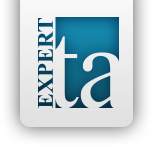Accessibility at Expert TA
Overview
In April 2024, the Department of Justice (or “Department”) published a rule that sets technical requirements for state and local governments to follow to make sure that their websites and mobile apps are accessible to people with disabilities. More about the details can be read here at the ADA’s webpage.
Expert TA is finalizing the deployment of system-wide accessibility upgrades to our technology and content and fully on track to meet this compliance deadline. Our suite of educational tools will be WCAG 2.1 Level AA Compliant as of December 2025, well before the April 2026 deadline.
Our Approach
Expert TA made its first major push and release towards Level AA accessibility compliance in mid 2022, and has made several releases since. We chose to go beyond simply meeting minimum accessibility standards and have made full accessibility compliance a central part of our mission.
Today, not only do our own technology and content meet current and upcoming standards, but we’ve also launched a platform that helps instructors convert non-compliant course materials into fully accessible formats. This means we can now partner with faculty and departments to ensure their course materials—whether originally in formats such as PDF or others—are transformed and delivered through our digital publishing platform in full compliance with accessibility guidelines. Learn more
Editable eBooks and Digital Publishing Platform
The platform delivers eBooks, hundreds of OER textbooks, and allows instructors to self-publish their course materials (either independently or with our support).
Platform and Content Compliance
- Keyboard-only navigation
- Screen-reader Compatible
- Alt Text for all Images
- Closed captions, transcripts, and audio descriptions
- All delivered math content has an underlying MathML representation and is rendered via MathJax with Assistivity enabled
Online Homework
Platform Compliance
- Keyboard-only navigation
- Screen-reader Compatible
- Alt Text for all Images
- Closed captions, transcripts, and audio descriptions
- All Math delivered content has an underlying MathML representation and is rendered via MathJax with Assistivity enabled
- Accessibility settings at roster level – for example if students need additional time on timed assignments. This prevents instructors from needing to configure each assignment and ensures students always have the proper settings.
Content Compliance
- Alt Text for all Images
- All Math delivered content has an underlying MathML representation and is rendered via MathJax with Assistivity enabled
- Question Types Supported (keyboard only and screen reader)
- True/False, Multiple Choice, and Multiple Select
- Short Answer and Essay
- Drag-and-Drop: Ranking, Sorting, and Labeling
- Numeric Calculation
- Symbolic Math Expression
- Free Body Diagram Drawing Tool (physics)
- Question Types Not Supported
- Click on Image (hotspot)
- Advanced Essay (This question type allows students not just to write text, but provides them with an interface that lets them create drawings to accompany their written explanations. This interface allows for items like: freeform sketches/pencil, arrows, shapes, text boxes, etc.. Although the drawing portion of this question type is not fully compliant. A regular essay question should be used as an alternate type when needed.
Commentary and Consideration: For a select few question types it is not possible/practical to offer those in a fully compliant manner and to do so in a way that doesn’t disadvantage visually impaired students with an increased/onerous time commitment.
An example of this is the “hotspot” or “click-on-image” question, for certain use cases of that question type. These activities ask students to do review an image of a section of the night sky and then click on the star whose color is associated with the coolest surface temperature. There are accessibility techniques for visually impaired students, such as sonification, but they require training and a time investment from the student to learn and understand distinct sounds and tones for different regions of the image. In the context of one question, of many, on an assignment, and where the expected time on task is 5-10 minutes, it would put the student in a disadvantaged position to use an approach that resulted in a much longer time on task for visually impaired students.
For cases such as this, the more practical strategy is to offer a question that is naturally compliant and gets at the same concept.
- Many Question Libraries consist of 100% compliant questions. All libraries consist of over 95+% compatible questions.
- Question Filtering for Compliance: The assignment editor allows instructors to filter out any questions that
- Question Authoring Tool: Every instructor has access to our intuitive and user-friendly question authoring tool. This tool can be used to make completely new questions, and can also be used to copy an existing Expert TA question and edit it. For the small percentage of questions in our library that are not compliant, instructors can use either select an existing alternate question that is compliant or use the authoring tool in order to create one.
